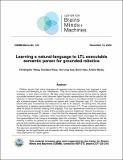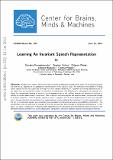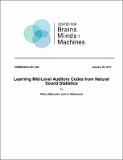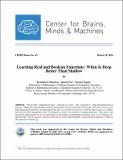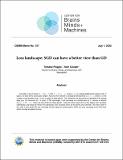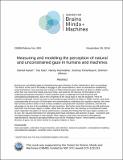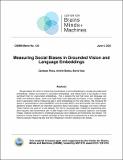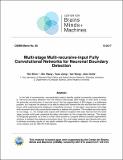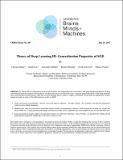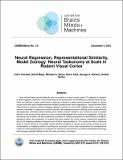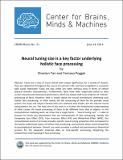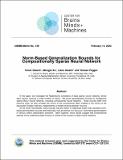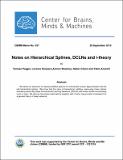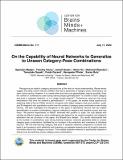Browsing CBMM Memo Series by Title
Now showing items 70-89 of 141
-
Learning a natural-language to LTL executable semantic parser for grounded robotics
(Center for Brains, Minds and Machines (CBMM), Conference on Robot Learning (CoRL), 2020-11-16)Children acquire their native language with apparent ease by observing how language is used in context and attempting to use it themselves. They do so without laborious annotations, negative examples, or even direct ... -
Learning An Invariant Speech Representation
(Center for Brains, Minds and Machines (CBMM), arXiv, 2014-06-15)Recognition of speech, and in particular the ability to generalize and learn from small sets of labelled examples like humans do, depends on an appropriate representation of the acoustic input. We formulate the problem of ... -
Learning Mid-Level Auditory Codes from Natural Sound Statistics
(Center for Brains, Minds and Machines (CBMM), arXiv, 2017-01-25)Interaction with the world requires an organism to transform sensory signals into representations in which behaviorally meaningful properties of the environment are made explicit. These representations are derived through ... -
Learning Real and Boolean Functions: When Is Deep Better Than Shallow
(Center for Brains, Minds and Machines (CBMM), arXiv, 2016-03-08)We describe computational tasks - especially in vision - that correspond to compositional/hierarchical functions. While the universal approximation property holds both for hierarchical and shallow networks, we prove that ... -
Loss landscape: SGD can have a better view than GD
(Center for Brains, Minds and Machines (CBMM), 2020-07-01)Consider a loss function L = ni=1 l2i with li = f(xi) − yi, where f(x) is a deep feedforward network with R layers, no bias terms and scalar output. Assume the network is overparametrized that is, d >> n, where d is the ... -
Measuring and modeling the perception of natural and unconstrained gaze in humans and machines
(Center for Brains, Minds and Machines (CBMM), arXiv, 2016-11-28)Humans are remarkably adept at interpreting the gaze direction of other individuals in their surroundings. This skill is at the core of the ability to engage in joint visual attention, which is essential for establishing ... -
Measuring Social Biases in Grounded Vision and Language Embeddings
(Center for Brains, Minds and Machines (CBMM), Annual Conference of the North American Chapter of the Association for Computational Linguistics (HLT/NAACL), 2021-06-06)We generalize the notion of measuring social biases in word embeddings to visually grounded word embeddings. Biases are present in grounded embeddings, and indeed seem to be equally or more significant than for ungrounded ... -
Multi-stage Multi-recursive-input Fully Convolutional Networks for Neuronal Boundary Detection
(Center for Brains, Minds and Machines (CBMM), 2017-10-01)In the field of connectomics, neuroscientists seek to identify cortical connectivity comprehensively. Neuronal boundary detection from the Electron Microscopy (EM) images is often done to assist the automatic reconstruction ... -
Musings on Deep Learning: Properties of SGD
(Center for Brains, Minds and Machines (CBMM), 2017-04-04)[previously titled "Theory of Deep Learning III: Generalization Properties of SGD"] In Theory III we characterize with a mix of theory and experiments the generalization properties of Stochastic Gradient Descent in ... -
Neural Regression, Representational Similarity, Model Zoology Neural Taskonomy at Scale in Rodent Visual Cortex
(Center for Brains, Minds and Machines (CBMM), The Thirty-fifth Annual Conference on Neural Information Processing Systems (NeurIPS), 2021-12-06)How well do deep neural networks fare as models of mouse visual cortex? A majority of research to date suggests results far more mixed than those produced in the modeling of primate visual cortex. Here, we perform a ... -
Neural tuning size is a key factor underlying holistic face processing
(Center for Brains, Minds and Machines (CBMM), arXiv, 2014-06-14)Faces are a class of visual stimuli with unique significance, for a variety of reasons. They are ubiquitous throughout the course of a person’s life, and face recognition is crucial for daily social interaction. Faces are ... -
A Nonparametric Bayesian Approach to Uncovering Rat Hippocampal Population Codes During Spatial Navigation
(Center for Brains, Minds and Machines (CBMM), arXiv, 2014-12-01)Rodent hippocampal population codes represent important spatial information about the environment during navigation. Several computational methods have been developed to uncover the neural representation of spatial topology ... -
Norm-Based Generalization Bounds for Compositionally Sparse Neural Network
(Center for Brains, Minds and Machines (CBMM), 2023-02-14)In this paper, we investigate the Rademacher complexity of deep sparse neural networks, where each neuron receives a small number of inputs. We prove generalization bounds for multilayered sparse ReLU neural networks, ... -
A normalization model of visual search predicts single trial human fixations in an object search task.
(Center for Brains, Minds and Machines (CBMM), arXiv, 2014-04-25)When searching for an object in a scene, how does the brain decide where to look next? Theories of visual search suggest the existence of a global attentional map, computed by integrating bottom-up visual information with ... -
Notes on Hierarchical Splines, DCLNs and i-theory
(Center for Brains, Minds and Machines (CBMM), 2015-09-29)We define an extension of classical additive splines for multivariate function approximation that we call hierarchical splines. We show that the case of hierarchical, additive, piece-wise linear splines includes present-day ... -
Object-Oriented Deep Learning
(Center for Brains, Minds and Machines (CBMM), 2017-10-31)We investigate an unconventional direction of research that aims at converting neural networks, a class of distributed, connectionist, sub-symbolic models into a symbolic level with the ultimate goal of achieving AI ... -
On Invariance and Selectivity in Representation Learning
(Center for Brains, Minds and Machines (CBMM), arXiv, 2015-03-23)We discuss data representation which can be learned automatically from data, are invariant to transformations, and at the same time selective, in the sense that two points have the same representation only if they are one ... -
On the Capability of Neural Networks to Generalize to Unseen Category-Pose Combinations
(Center for Brains, Minds and Machines (CBMM), 2020-07-17)Recognizing an object’s category and pose lies at the heart of visual understanding. Recent works suggest that deep neural networks (DNNs) often fail to generalize to category-pose combinations not seen during training. ... -
On the Forgetting of College Academice: at "Ebbinghaus Speed"?
(Center for Brains, Minds and Machines (CBMM), 2017-06-20)How important are Undergraduate College Academics after graduation? How much do we actually remember after we leave the college classroom, and for how long? Taking a look at major University ranking methodologies one can ... -
On the Robustness of Convolutional Neural Networks to Internal Architecture and Weight Perturbations
(Center for Brains, Minds and Machines (CBMM), arXiv, 2017-04-03)Deep convolutional neural networks are generally regarded as robust function approximators. So far, this intuition is based on perturbations to external stimuli such as the images to be classified. Here we explore the ...

